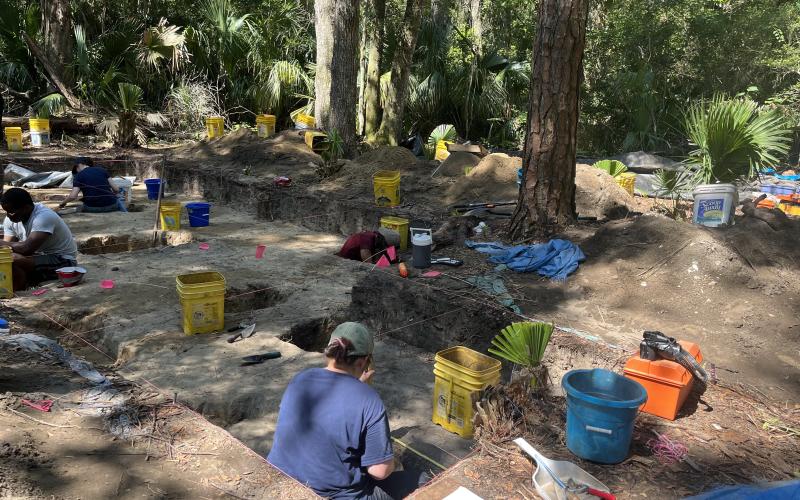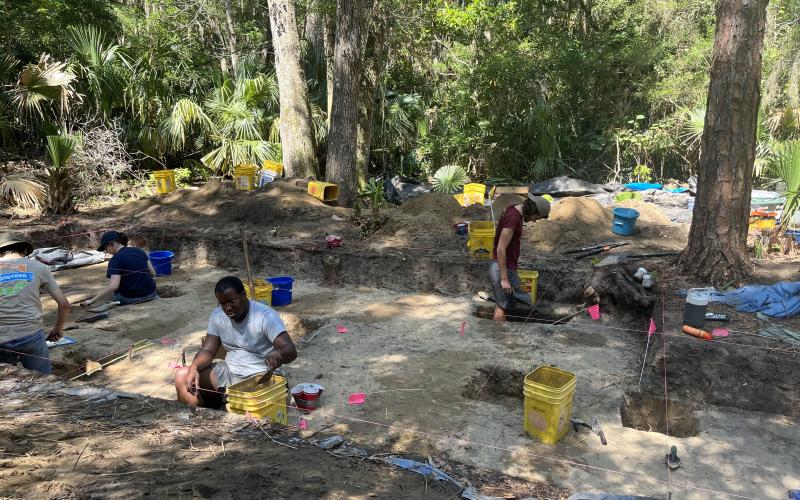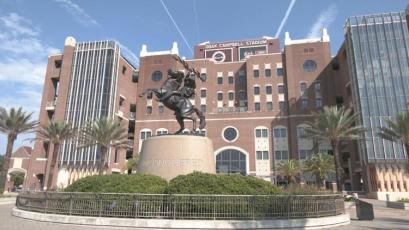Deep in the woods in Big Talbot Island State Park, archeologists are unearthing a whole town one pottery shard at a time.
The University of North Florida Archeology Lab is led by Keith Ashley, and he and the students have been hard at work for years now unearthing the town of Sarabay, home to the indigenous Timucua-speaking Mocama people.
“It’s probably just one of 10 communities that’s in the area,” Ashley said, “but it was probably a moderate- to large-sized community that was living here.”
Ashley and the UNF students have identified several areas of interest at the site. Each piece of land is excavated in plots three feet by six feet, and between the original dig in 1998 and the current one, 160 units have been excavated.
The team gently pulls back the earth covering the artifacts 10 centimeters at a time. Once they’ve reached a certain depth, they mark places with organic stains. These stains are darker pieces of earth where wood posts once stood and have since rotted away. At the heart of the archeological site, the team believes they’ve found what would have been the community center or council house for the town.
Ashley pointed out where the team had marked each post found so far. Together, they form a sort of arc with the posts about two meters apart from each other. The team is currently working to find the intersecting line to complete the building outline while also excavating pieces inside the boundaries.
At the heart of this find is an effort to put indigenous people back into their own story.
“The things we know about what went on in these communities is filtered through 16th century European lenses,” Ashley said. “So it’s all biased towards the way they want to interpret things. So we’re able to try to look at it here and try to shift the perspective from a European perspective to an indigenous perspective. We want to center indigenous people in the history.”
Recentering the story is a long process, Ashley said, but a good place to start is the language used.
“We’re starting to use indigenous languages for certain things,” he said. “If they want to refer to this person as a ‘king’ or ‘chief’ … we start to use and imbed indigenous languages wherever we can.”
The Timucuan word for their leaders is “holata,” and it’s the word Ashley uses when referring to the leaders.
“It’s also looking at things in terms of seeing the Europeans as visitors to an indigenous world,” he said. “We try to look at all the long-lasting traditional kinds of networks that were already in existence and look at things from those kinds of perspectives. So it’s not trying to erase Europeans at all.”
Sarabay and the surrounding towns were occupied by the Timucua-speaking Mocama people. They built towns and traded with European visitors, both evidenced by finds at the site. Students have found glass beads with bits of gold, pottery shards with distinctive markings and some finds they’re still trying to puzzle out.
Despite the long hours digging holes, the intense summer heat and the pesky mosquitoes, the students are loving their chance to be a part of the dig.
“I did this in 2020,” one student said, “and I was waiting a year to do it again. Like just being in the field was my favorite part.”
They talk with excitement about the things they’ve found, even the animal bones that came years after the town was abandoned. They talk about the glass bead with bits of gold, old stones and the biggest pieces of pottery they’ve found (none of which were bigger than just the rim of the pot) all while using kitchen spoons to scoop dirt into a dust pan.
“These students work so hard,” Ashley said. “I get to be this mouthpiece all the time for everything, but they’re doing so much of the work here …. This is not them sitting around watching a bunch of archeologists do it. They are the archeologists that are out here.”
hdorman@fbnewsleader.com





